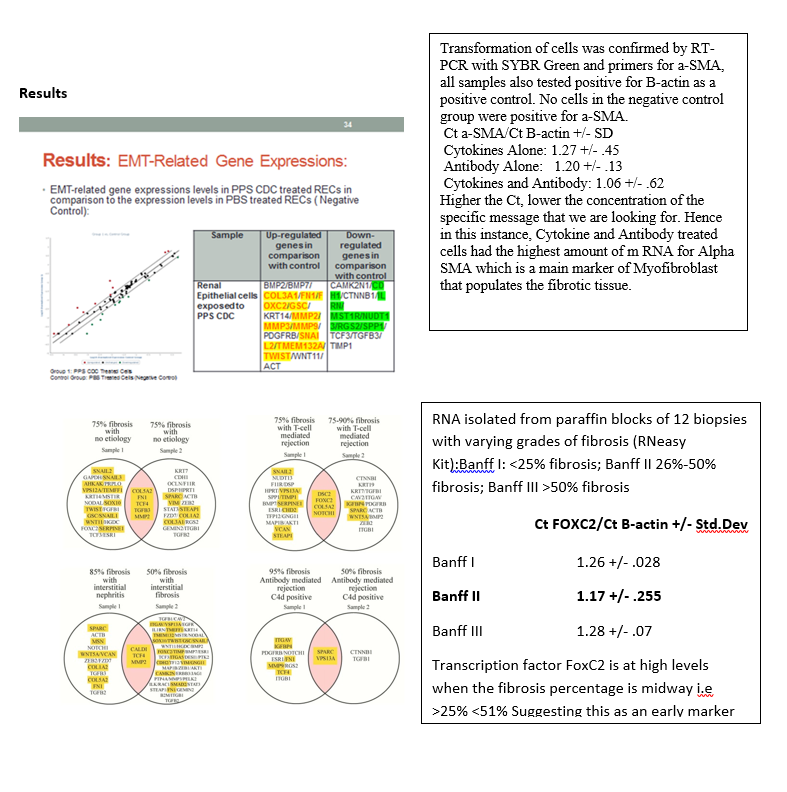Biomarkers of Epithelial-Mesenchymal Transition (EMT) in Chronic Allograft Nephropathy: Potential for Early Detection and Development of Novel Therapeutic Agents.
Pathology, BioChemistry and Medical Laboratory Sciences, Rush University Medical Center, Chicago, IL
Meeting: 2017 American Transplant Congress
Abstract number: D257
Keywords: Alloantibodies, Antilymphocyte antibodies, Biopsy, Graft failure
Session Information
Session Name: Poster Session D: Long Term Kidney Outcomes
Session Type: Poster Session
Date: Tuesday, May 2, 2017
Session Time: 6:00pm-7:00pm
 Presentation Time: 6:00pm-7:00pm
Presentation Time: 6:00pm-7:00pm
Location: Hall D1
Purpose: To detect markers and novel treatment targets related to fibrogenesis and eventual graft loss by focusing on Epithelial Mesenchymal transition (EMT) which requires understanding the mechanisms of allograft fibrogenesis. Methods: Using Real Time Quantitative RT-PCR, Western Blot,Chromatography to identify fragments of proteins: 1. In vitro Model: To expose human renal tubular epithelial cells to cytokines, cytokines and anti-HLA antibodies and to monitor for morphological changes and also to detect markers related EMT; 2. In Vivo Model: To determine EMT related gene expression profile in biopsy specimens with varying degrees of fibrosis; 3. To determine the potential for using antibodies against various isoforms of Vimentin, a marker of fibrosis, as a surrogate marker for development of fibrosis and distinction of different etiologies of allograft rejection.
We tested different etiologies of Allograft rejections namely, Antibody mediated, T-Cell mediated, Polyoma virus mediated etc. and our preliminary findings indicate that antibodies against certain specific fragments of Vimentin, a marker of fibrogenesis, might have the potential to distinguish different types of allograft rejections. This may lead to further mechanistic studies of chronic rejection manifested by irreversible fibrosis.
onclusions: Here we show that transition of allograft epithelial cells to mesenchymal phenotype (EMT) could contribute towards fibrogenesis. Our initial studies show both in vitro and in vivo evidence for EMT related gene expression pattern from two independent experiments. Considering the costs of a secondary or tertiary transplant, the investment to find novel, early biomarkers based on mechanisms of fibrogenesis seems worthwhile. More details regarding the antibody responses towards various isoforms of Vimentin will be presented.
CITATION INFORMATION: Kanangat S, Miller R, Rezaeian S, Eldib H, Cimbaluk D, Fhied C, Kurbegovic-Skaljic I, Prod M, Borgia J, Flaws M, Castillo D, DeCresce R. Biomarkers of Epithelial-Mesenchymal Transition (EMT) in Chronic Allograft Nephropathy: Potential for Early Detection and Development of Novel Therapeutic Agents. Am J Transplant. 2017;17 (suppl 3).
To cite this abstract in AMA style:
Kanangat S, Miller R, Rezaeian S, Eldib H, Cimbaluk D, Fhied C, Kurbegovic-Skaljic I, Prod M, Borgia J, Flaws M, Castillo D, DeCresce R. Biomarkers of Epithelial-Mesenchymal Transition (EMT) in Chronic Allograft Nephropathy: Potential for Early Detection and Development of Novel Therapeutic Agents. [abstract]. Am J Transplant. 2017; 17 (suppl 3). https://atcmeetingabstracts.com/abstract/biomarkers-of-epithelial-mesenchymal-transition-emt-in-chronic-allograft-nephropathy-potential-for-early-detection-and-development-of-novel-therapeutic-agents/. Accessed November 20, 2025.« Back to 2017 American Transplant Congress

